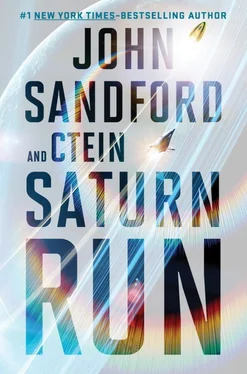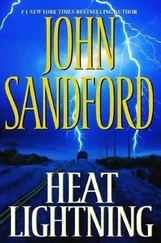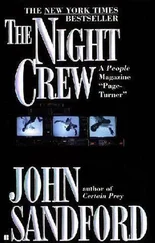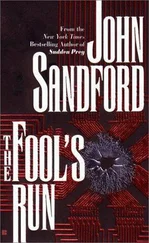Crow nodded and said, “You’re right. About all of it.” He stood up, climbed out of the van, and said to the marshals, who were waiting on the sidewalk, “Let him out.”
As the marshals came around, Sandy said, “You knew I’d been up to something. Why?”
“’Cause you once told me that you’d not only do what we want, you’d do what we need,” Crow said. “I believed you. Plus, of course, that shit-eating grin that would pop onto your face, from time to time, during the trial. Santeros actually spotted it.”
“Huh. Gotta work on that,” Sandy said. “Uh, why are the marshals just… letting me go?”
“They’re not exactly marshal-type marshals, if you take my meaning.”
“Did you ever catch your spy?”
“Can’t talk about that.”
“Did you ever figure out how he was communicating with the Chinese?”
“No, never did.”
“I read that Elroy Gorey died when the GPS went crazy on a twenty-wheeler, swerved across the road and killed him.”
“A tragedy,” Crow said. “We all felt terrible.” Neither his voice nor his face showed the slightest inflection.
The marshals freed him and Sandy climbed out of the van. Crow handed him an envelope. On the outside it said simply: “The White House.”
“What’s this?”
“The pardon,” Crow said. “I’ll work on the apology. Listen, my car’s right around the corner. You need a lift?”
2179
DEEP SPACE
The sun was the most brilliant star in the sky, but that was all that distinguished it from other stars. The white-hot pinprick shed barely as much light as the quarter moon did on Earth, three thousand AU away. It did little to illuminate the ship gliding through the inner Oort cloud.
Earth’s first truly deep space mission had already satisfied two of its three mission objectives. The run out to the Oort cloud was the final field test of the technology critical to the interstellar vessel currently under construction in high Earth orbit. Long-duration antimatter containment and propulsion was a proven reality, and deep-space, self-contained life support a proven technology.
The ship’s second objective had been to sample several primordial Oort cloud objects, comets yet to be born. It was science’s first chance to study truly pristine material from the formation of the solar system and an excellent trial run for the remote-sensing and physical investigation procedures that would be integral to the interstellar ship’s research.
The ship closed on its final objective.
Two service modules jetted out from the ship’s air lock. Ever so carefully, mindful of four billion pairs of watching eyes back on Earth, they matched velocities with a vaguely egg-shaped module of antique design, human sized, encrusted with insectile appendages, ports, windows, and cameras. The main port was cracked. Crushed storage lockers and canisters surrounded the base of the egg.
There was a small hole in the egg’s shell.
The two modern modules linked to the antique’s grappling rings. Ever so gently, they shepherded it into the ship’s air lock.
The lock closed.
The ship rotated until its nose pointed toward the sun.
Antimatter engines flared, immeasurably brighter than the distant pinpoint sun. In two years, the crew would be back on Earth, accompanied by Dr. Rebecca Johansson, the first voyager and the first casualty of the interstellar age, who was finally returning home.
AUTHORS’ NOTE: THE SCIENCE BEHIND THE STORY
Dear Reader:
DON’T read this until you’ve read the novel, because you’ll get a whole bunch of spoilers. Some people are fine with that. We know people who read the ends of mysteries first so they can find out whodunit and then enjoy the run-up. We’re just warning you.
The science fiction author Greg Benford talks about “wantum mechanics.” It’s the totally made-up non-science that saves the crew in the last dozen minutes of a bad Star Trek episode. “Captain, if we invert the polarity of the phasers and couple them to the warp drive, we can produce a beam of the never-before-heard-of unbelievablon particles and render the enemy’s fleet helpless.”
That’s one kind of thrill ride, and it’s fun. But we wanted to write the kind of high-tech, hard-science thriller where you can’t just make up stuff to solve your problem—where you have to deal with the real lemons that life hands you, to make your lemonade.
Such a problem is right where we started. One of us (John) had this idea for a novel. To give the story the right pacing, it needed spaceship technology that wouldn’t take decades to build and could get to Saturn in less than six months. Even setting the story five decades from now, he didn’t know how to do that without just making stuff up—wantum mechanics. So he reached out to the other of us and said, “Ctein, can you figure out how to make this work, because if you can, we might have ourselves a novel.”
Cut to the finale. He did, and we did, and you just read it.
____
Here’s some of the science behind the story:
The Big Problem is that space travel is hard. “Rocket science” became synonymous with “really hard” for good reasons. Getting anywhere fast is really, really hard. We couldn’t come up with any way to meet the timetable we wanted with present-day technology, so the story is set half a century from now.
It is, in fact (well, in fiction) a fairly boring half century. For the sake of our story we decided that space travel won’t make much more progress in the next four or five decades than it has in the last four or five. Science fiction is a game of what-if, not accurately predicting the future.
Still, if you’d told someone back in 1969, at the time of the first moon landing, that nearly half a century later humans wouldn’t be doing anything outside of low Earth orbit, not even going back to the moon, they’d have thought you were crazy. It certainly wasn’t what your typical science fiction author imagined for the next fifty years. Depressing as the thought is, our scenario may not be as implausible as we’d like to believe.
With fifty years’ worth of steady and predictable technological advancements, we could pull off the science. That still doesn’t make space travel easy. Space travel’s hard because you need high velocities to get anywhere fast, and it’s really hard to get high velocities. It takes appalling amounts of energy.
Typical solar system travel times are usually measured in years. The simplest low-velocity, long-duration trip from Earth to Saturn takes about seven years. It’s called a “Hohmann transfer” and you can read about it in Wikipedia. That’s way too slow for our story. Even then, it takes about as much additional velocity—seven kilometers per second (km/s)—to get yourself from high Earth orbit onto a trajectory that reaches Saturn, as it does to get into Earth orbit in the first place.
Once you get to Saturn, you’ll need more delta-vee (rocket scientist shorthand for the change in velocity that you’re making) to kill some of your initial velocity, so you’ll put yourself in orbit about Saturn instead of flying on past. Then you’ll need similar amounts of delta-vee to get you home again, and back into Earth orbit. That’s why almost all the robotic probes we’ve sent out have been one-way missions; returning home means you need a lot more delta-vee at your disposal.
You might be thinking, well what’s so tough about that? If it takes a total of twice as much velocity to get you to Saturn as it does to get into Earth orbit, just make the rocket twice as big. Okay, maybe three times as big to account for getting into orbit around Saturn. And the same amount to get you back again. That doesn’t seem that hard.
Читать дальше








